Chemical and Process Engineering Resources
Extractive Distillation: An In-Depth Look
Nov 08 2010 01:40 PM | Chris Haslego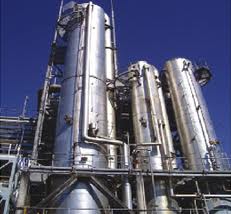
A Sample Distillation Process
For our example which deals with the azeotropic mixture formed between benzene and cyclohexane, we have chosen extractive distillation (one of the homogeneous azeotropic distillation methods). The reason of choosing this method is due to the availability of information regarding this separation technique and its tendency to operate more efficiently, i.e. in separating and recycling the separating agent. A brief discussion of the process is given below.
After the mixture exited as the bottom product of the flash unit, it contains mostly our desire product of cyclohexane and also a significant amount of unreacted benzene, which is to be recycled back to the reactor for further conversion. Our main goal now is to further separate the remaining components in the mixture. As cyclohexane and benzene have been encounter most of the remaining composition with the mole % of 44.86 and 54.848 respectively (Table 1), we will consider this to be a binary mixture in our further discussion.
From the process flowsheeting, we would like to operate the distillation column at the pressure of 150 kPa. At this condition, cyclohexane and benzene will have boiling points of 94.34 °C and 93.49 °C respectively (Figure 3). This is a typical case where conventional distillation would struggle to perform the separation of this type of close boiling mixture. Thus, a special type of distillation technique, i.e. extractive distillation has been chosen in order to purify the desire product, i.e. cyclohexane to our desired purity of 99.3%.
As can be shown from Figure 3, this binary composition will form a minimum boiling, homogeneous azeotrope at the temperature of 91oC and the corresponding composition at this point will be 45.5 mole % for cyclohexane and 55.5 mole % for benzene (Figure 4).
| Temperature | 5.4279 °C |
| Pressure | 1376.6 kPa |
| Molar Flow Rate (kg mol/h) | Â |
| Hydrogen | 0.914 |
| Cyclohexane | 159.447 |
| Benzene | 194.944 |
| n-Hexane | 0.127 |
| Total | 355.430 |
| Mole % Composition | Â |
| Hydrogen | 0.256 |
| Cyclohexane | 44.861 |
| Benzene | 54.846 |
| n-Hexane | 0.036 |
| Total | 1.000 |
Â
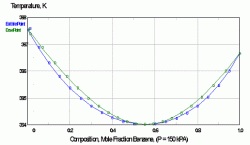 | 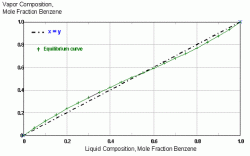 |
| Figure 3: T-xy Plot for Benzene and Cyclohexane | Figure 4: x-y Plot for Benzene and Cyclohexane at 150 kPa |
Â
Solvent Selection for the Benzene-Cyclohexane Binary Mixture
In order to perform a successive extractive distillation, a solvent needs to be chosen to "break" the azeotrope that forms at the operating pressure of the distillation column. Recommended solvent for the benzene-cyclohaxane mixture from the literature,,, is aniline, with a solvent to feed ratio (S/F) of 4, which will shift the azeotropic point toward the corner of the high-boiling component cyclohexane, and the equilibrium curve of the original components fall below the diagonal (Figure 5).
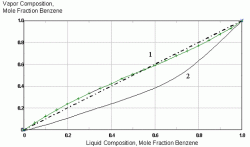 |
| Figure 5: Elimination of Azeotropic Point with the Addition of a Separating Agent |
As was stated in the above section, the primary goal of solvent selection is to identify a group of feasible solvents to perform a good separation. The desired product, i.e. cyclohexane should have a purity of above 99% to meet the market standard. Aniline was the first solvent that had been put to the simulator to be tried out, as it is of the same homologous group as benzene. As can be shown from the result in Table 2, this solvent will produce the desire production rate of 150 with the solvent flow rate of 3500, i.e. a S/F ratio of 9.85. However, the product purity can only reach 70.08% and this does not meet our product specification. As a result, other solvent may have to be researched to perform the desire separation.
We will have to perform the solvent selection criteria as stated in the preceding section. At the column pressure of 150 kPa, cyclohexane and benzene boil at 94.34 °C and 93.49 °C respectively and form a minimum-boiling azeotrope at 91 °C. The natural volatility of the system is benzene > cyclohexane, so the favored solvents most likely will be those that cause the benzene to be recovered in the distillate. However, in order to get a better quality of product, we would like to recover cyclohexane as the distillate rather than from the bottom stream. Thus, solvent to be chosen should give positive deviations from Raoult's law for cyclohexane and negative (or zero) deviation for benzene.
| Feed Stream Molar Flow Rate (kg mol/h) | Â |
| Hydrogen | Â 0.914 |
| Cyclohexane | Â 159.447 |
| Benzene | Â 194.944 |
| n-Hexane | Â 0.127 |
| Total | Â 355.43 |
| Solvent Stream (Aniline) molar flow rate (kg mol/h) | Â 3500 |
| Solvent/Feed (S/F) ratio | 9.85 |
| Distillate Product Molar Flow Rate (kg mol/hr) | Â |
| Hydrogen | Â 0.914 |
| Cyclohexane | Â 150 |
| Benzene | Â 62.956 |
| n-Hexane | Â 0.127 |
| Aninline | Â 0.058 |
| Total | Â 214.05 |
| Mole % Composition in the Distillate Product | Â |
| Hydrogen | Â 0.427 |
| Cyclohexane | Â 70.08 |
| Benzene | Â 29.41 |
| n-Hexane | Â 0.059 |
| Aniline | Â 0.027 |
| Â Total | Â 1.000 |
Â
| Â | Â | Solvent Class | |||||||||||
| Solute Class | Group | 1 | 2 | 3 | 4 | 5 | 6 | 7 | 8 | 9 | 10 | 11 | 12 |
| 11 | Aromatic, olefin, halogen aromatic, multihola paraffine without active H, monohalo paraffine | + | + | + | 0 | + | 0 | 0 | - | 0 | + | 0 | 0 |
| 12 | Paraffin, carbon disulfide | + | + | + | + | + | 0 | + | + | + | + | 0 | + |
| Solvent/solute class | Group | Solvent/solute class | Group | ||||||||||
| 4 | Active -H in multihalo paraffin | 8 | Primanry amine, ammonia, amide with 2H or N Ether, oxide, sulfoxide | ||||||||||
| 7 | Secamine | 9 | |||||||||||
Turning to the Robbins Chart (Table 3), we note that solvents that may cause the positive deviation for cyclohexane (Class 12) and negative (or zero) to benzene (Class 11) came from the groups of 4, 7, 8 and 9, which consist of polyol, amine and ether. We further consider the solubility, the hydrogen bonding effect, and also the homologous characteristic of the solvent with the corresponding components in the feed mixture. As few candidate solvents that had been put to the computer simulation, included phenol (homologous to benzene), 1,2-benzenediol (homologous to benzene, with -OH group that will produce hydrogen bonding), 1,3-butanediol (with -OH group that will produce hydrogen bonding), and also 1,2-propanediol (same characteristic as with 1,3-butanediol). 1,2-propanediol (often known as propylene glycol), seem to give the most promising results compared to the other solvents. This result may be caused from the high solubility of benzene in this solvent and the hydrogen bonding that were formed between the two constituents. Simulation result of this solvent can be view in Table 4.
Construction of the Residue Curve
Equation 3 and 4 were used to sketch the corresponding residue curve for the three species. From the above information, we know that these species have boiling points at 94.34 (cyclohexane), 93.49 (benzene) and 200.35 oC (propylene glycol) at the pressure of 150 kPa, and an azeotrope that boils at 91 °C between the two more volatile species. As were shown from Figure 6 and Figure 7 there were no new azeotropes formed between the solvent 1,2-propanediol respectively with the another two component in the feed.
| Feed Stream Molar Flow Rate (kg mol/h) | Â |
| Hydrogen | Â 0.914 |
| Cyclohexane | Â 159.447 |
| Benzene | Â 194.944 |
| n-Hexane | Â 0.127 |
| Total | Â 355.43 |
| Solvent Stream (Aniline) molar flow rate (kg mol/h) | Â 3600 |
| Solvent/Feed (S/F) ratio | 10.13 |
| Distillate Product Molar Flow Rate (kg mol/hr) | Â |
| Hydrogen | Â 0.914 |
| Cyclohexane | Â 158.75 |
| Benzene | Â 0.075 |
| n-Hexane | Â 0.127 |
| 1,2 propanediol / propylene glycol | Â 0.004 |
| Total | Â 159.87 |
| Mole % Composition in the Distillate Product | Â |
| Hydrogen | Â 0.571 |
| Cyclohexane | Â 99.30 |
| Benzene | Â 0.047 |
| n-Hexane | Â 0.079 |
| 1,2 propanediol / propylene glycol | Â 0.003 |
| Â Total | Â 1.000 |
Â
We then start to sketch our residue curve map by sketching the triangular diagram in Figure 8, and placing the arrows pointing from the lower to higher temperatures around the edge. The corner points for benzene and cyclohexane are single species point, and both are unstable nodes - all residue curves leave. The corner point for propylene glycol is a single species point which is a stable node - all residue curve enter. All three are nodes; none are saddles, thus;
N1 = 3 and S1 = 0
We then further assume that there will be no ternary azeotrope been form among the three constituents, i.e.,
N3 = S3 = 0Â
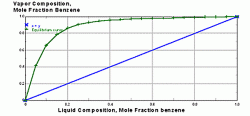 | 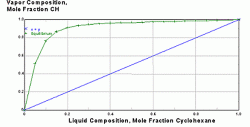 |
| Figure 6: x-y Plot for Benzene and Propylene Glycol | Figure 7: x-y Plot for Cyclohexane and Propylene Glycol |
Â
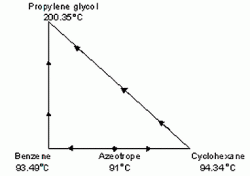 |
| Figure 8: Preliminary Sketch for Residue Curve |
The remaining steps here require the identification of the only binary azeotrope that form between benzene and cyclohexane, to be either a node or a saddle point. From equation 4:
4(0-0) + 2(N2 - S2) + (3-0) = 1
2(N2 - S2) = -2
N2 - S2 = -1
Thus, the only way we can satisfy the above equation is letting N2 = 0 and S2 = 1, i.e. the binary azeotrope is a saddle point, which directs the trajectories in another direction.
Â
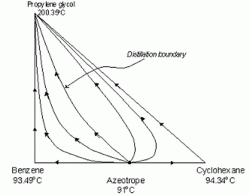 |
| Figure 9: Completed Sketch for Residue Curve |
Column Operation
The extractive distillation unit of this cyclohexane production plant consists of two distillation columns (Figure 10), which we can easily classify as direct sequence columns. The first column acts as an extractive column where the solvent is introduced at the second stage of the column, so that it will be present throughout the column and exits with the bottoms. As were stated above, the solvent alters the natural volatility of the binary mixture by forming hydrogen bonds with benzene and allowing it to be recovered as the bottom product.
The bottom product of the first column will then fed to the second column, i.e. the solvent recovery column, to undergo the normal distillation to separate both the components for further usage, i.e. benzene being recycled to the reactor for further conversion while solvent to the first column for reuse. The main operation parameter of the distillation unit is shown in Table 5.
| Unit Operation and Stream | Description | Operating Parameters |
| Distillation Column | ||
| T-20 | First column (extractive column) | Operating pressure: 150 kPa Number of trays: 45 Solvent (str. 27) feed tray: 2 Feed (str. 47) tray = 28 |
| T-21 | Second column (solvent recovery column) | Operating pressure: 105 kPa Number of trays: 20 Feed stream: 10 |
| Heat Exchanger | ||
| X-22 | Cool down the solvent for recycling | Outlet temperature: 80 °C |
| Pump | ||
| P-23 | Pump the solvent for recycling | Outlet pressure: 150 kPa |
| Stream | ||
| Stream 27 | Solvent stream of 1,2-propanediol | Molar flow rate: 3600 kgmol/h |
| Stream 47 | Feed stream | Molar flow rate: 355.43 kgmol/h |
| Stream 28 | Product stream of Column T-20 distillate (cyclohexane) | Molar flow rate: 158.75 kgmol/h with a purity of 99.3% |
| Stream 29 | Benzene solvent stream of bottom product from column T-20, fed to solvent recovery column T-21 | Molar flow rate: 3795.5 kgmol/h with a purity of 94.8% |
| Stream 30 | Product stream of column T-21 distillate (benzene) for recycle | Molar flow rate: 223.91 kgmol/h with a purity of 84.96% benzene |
| Stream 31 | Solvent stream of bottom product from column T-21 (solvent) for recycle | Molar flow rate: 3571.6 kgmol/h with a purity of 99.87% solvent |
Â
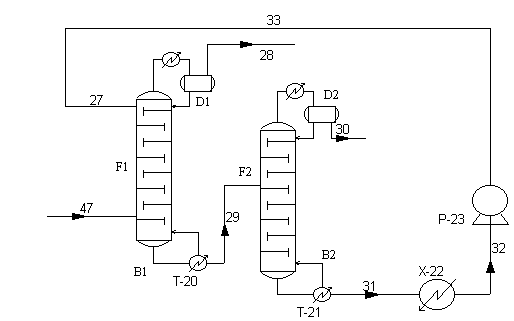 |
| Figure 10: Extractive Distillation Unit for Cyclohexane Production Plant |
Â
Â
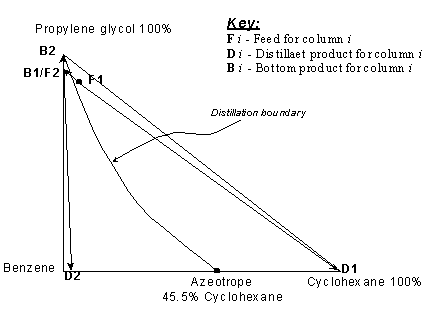 |
| Figure 11: Distillation Ternary Diagram for the Extractive Distillation Unit |
Â

 FB
FB

3 Comments
nice discription. thanks
Thank you for brief explaination.
good